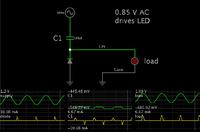jayanth.devarayanadurga
Banned
- Joined
- Dec 4, 2012
- Messages
- 4,280
- Helped
- 822
- Reputation
- 1,654
- Reaction score
- 791
- Trophy points
- 1,393
- Location
- Bangalore, India
- Activity points
- 0
Please explain the working of the unbiased Positive clamper circuit shown here.
**broken link removed**
From t0 to t1 the C charges to Vm say (Vm = Vi - 0.7V)
Vm is -10V for ideal diode.
Now Voltage from + side of C to gnd is +10V
Now Vi increases from -10 to 0V during t1 to t2
I want KVL for this condition that is when t = t1 to t2 (as diode anode is still +Ve and left side of C is still -Ve)
**broken link removed**
From t0 to t1 the C charges to Vm say (Vm = Vi - 0.7V)
Vm is -10V for ideal diode.
Now Voltage from + side of C to gnd is +10V
Now Vi increases from -10 to 0V during t1 to t2
I want KVL for this condition that is when t = t1 to t2 (as diode anode is still +Ve and left side of C is still -Ve)
